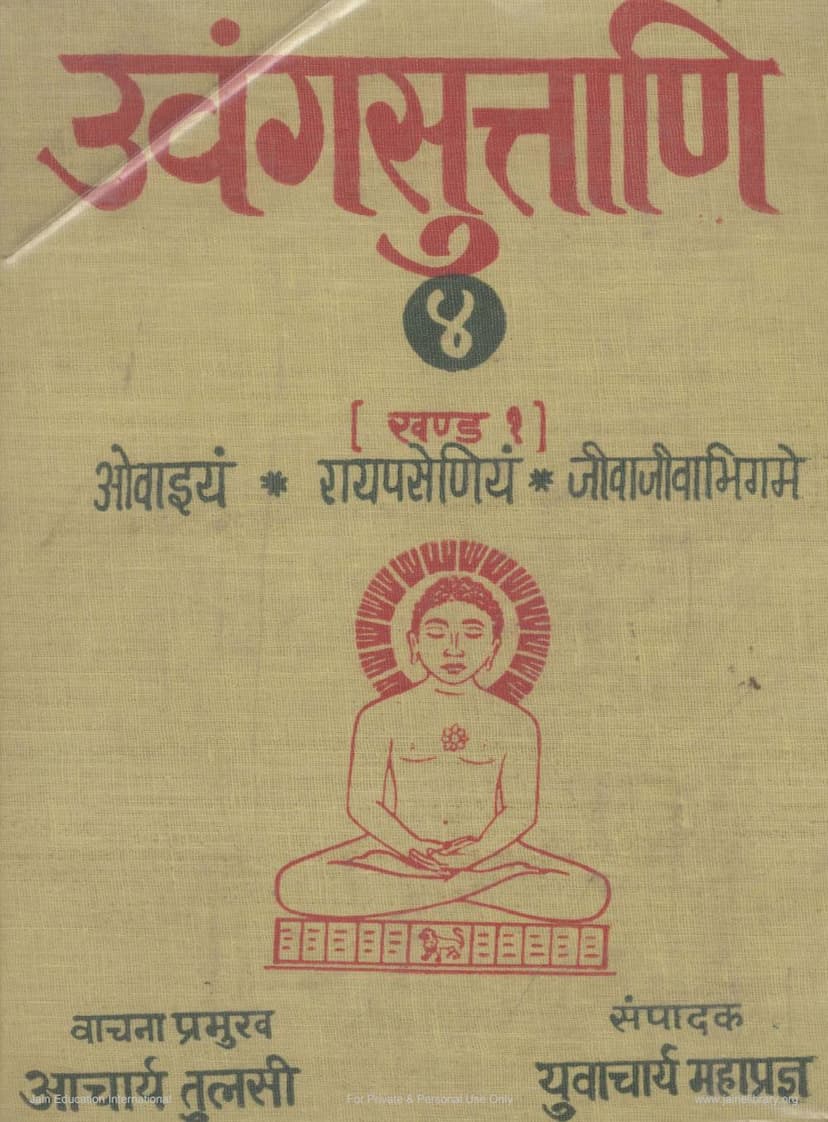Uvangsuttani Part 04 Ovayiam Raipaseniyam Jivajivabhigame
Added to library: September 2, 2025

Summary
The provided text is a portion of the Uvangasuttani Part 04, specifically containing the Ovayiam (Aupapātika), Rāyapaseṇiyaṁ (Vyākaraṇa), and Jivājivābhidhama (Ājivābhigama) texts, critically edited by Acharya Tulsi and edited by Yuwacharya Mahapragna, published by Jain Vishva Bharati.
Here's a comprehensive summary in English based on the provided pages:
Overall Scope and Context:
- This publication is part of a larger series, "Niggantbam Pāvayanam UVANGA SUTTANI," dedicated to critically editing and publishing Jain Āgamas.
- The volume, specifically Part IV (Part 1), contains three Upānga Āgamas: Ovāiyam, Rāyapaseṇiyaṁ, and Jivājivābhidhama.
- The publication is dedicated to the Amrit Mahotsava year of Ācārya Tulsi, highlighting the significance of this scholarly endeavor.
- The work is presented as being for "Private & Personal use only," indicating its intended audience within the Jain scholarly or religious community.
Key Āgamas Included and Their Significance:
-
Ovāiyam (Aupapātika):
- Title Meaning: The text's name, "Ovāiyam," is derived from "Oupapātika," signifying "that which pertains to Upapāta" (cosmic birth or manifestation).
- Core Subject: Its main theme is rebirth, explaining how specific actions lead to particular types of future births. It also includes incidental descriptions of samavasarana (assembly places of Tirthankaras).
- Descriptive Nature: It is characterized as a "repository of descriptions" (varnana-kosh), featuring detailed descriptions of cities, temple complexes (chaityas), gardens, kings, queens, etc. These descriptions are often referenced in other Āgamas with the phrase "Jaha Ovavāie" (as in Aupapātika).
- Commentaries: The earliest known commentary is by Abhayadeva Suri, who noted the abundance of variant readings (vachana-bheda) within this text, emphasizing the challenge in establishing a definitive version. Another commentary, "Stabaka," is also mentioned.
- Significance of Variant Readings: The text highlights the importance of collecting and referencing these variant readings for linguistic and textual study. The publication includes extensive footnotes and appendices detailing these textual variations and providing comparative analysis.
-
Rāyapaseṇiyaṁ (Rājapraśnīya):
- Title Meaning: The name is linked to King Pradeśi (or Pradesi) and his questions to Kesi-svāmi, the disciple of Lord Mahāvīra, concerning the soul and its states. While Malayagiri favored "Rājapraśnīya," the text discusses linguistic arguments for the form "Rāyapaseṇiyaṁ" (or "Rāyapaseṇaiyam").
- Core Subject: The primary focus is the dialogue between King Pradeśi and Kesi-svāmi, exploring philosophical concepts, karma, rebirth, and the nature of the soul.
- Commentaries: The major commentaries mentioned are by Ācārya Malayagiri (in Sanskrit) and later by Pārśvacandra Gaṇī and Muni Dharamsingh (in Gujarati-mixed Rajasthani). Malayagiri's commentary is noted for its detailed explanations and discussions on textual variations and interpretations, often referencing the Jivājīvābhigama.
- Textual Challenges: The editors acknowledge the significant problem of variant readings in this text and the labor involved in determining the final text, aiming for neutrality and accuracy.
-
Jivājivābhidhama (Jivājivābhigama):
- Title Meaning: The name signifies a "detailed exposition of Jiva (soul) and Ajiva (non-soul)."
- Core Subject: The Āgama primarily focuses on the classification of Jiva (soul) and Ajiva (non-soul) through various numerical categories. It covers a vast range of categories, from the two types of mundane souls (mobile and immobile) to nine and ten types, with detailed enumeration based on senses, life-forms, states of existence, etc.
- Content: It also delves into the characteristics of hellish beings, animals, humans, and celestial beings. The text contains specific descriptions of architectural elements like Padmavaravedika (lotus altar) and Vijayadvāra (gate of victory). It also compiles various "ādeśas" (viewpoints or doctrines), acknowledging differing opinions among ancient scholars (Sthaviras) on certain topics.
- Compilation of Views: The text serves as a compilation of diverse perspectives, particularly those of the Sthaviras, on subjects like the nature of souls and the universe, without necessarily arriving at a definitive conclusion on all matters, reflecting the historical context of its composition.
- Commentaries: Two commentaries are noted: one by Acārya Haribhadra (concise) and another by Ācārya Malayagiri (extensive). Malayagiri's commentary is highlighted for referencing earlier works, including the "Jivājīvābhigama Mūla Ṭīkā" and "Chūrṇi."
- Linguistic and Textual Importance: The text includes an extensive section on "shabdāntara" (variant words) and "rūpāntara" (variant forms), crucial for linguistic and Āgamic studies.
Editorial and Scholarly Aspects:
- Critical Editing: The publication emphasizes the critical editing of the original texts, including the presentation of variant readings (pāṭhāntara) and reference to manuscript sources.
- Guidance and Support: Ācārya Tulsi is acknowledged as the "Vācanā-pramukha" (chief guide for the recension/teaching), and Yuwacharya Mahapragna as the "Editor" and "Vivechak" (analyst/discourser). Numerous monks and nuns are credited as collaborators in text revision and other editorial tasks.
- Language and Presentation: The text is presented in its original Prakrit form, with extensive footnotes and introductions, some of which are in Hindi and English, providing context and scholarly analysis.
- Commemoration: The publication is linked to Ācārya Tulsi's Amrit Mahotsava year, indicating a significant milestone in Jain scholarship.
- Collaborative Effort: The publisher, Jain Vishva Bharati, is credited with the publication, with managing editors and financial contributors also acknowledged, underscoring the collaborative nature of this academic undertaking.
In essence, this publication represents a significant scholarly effort to preserve, critically edit, and disseminate three important Upānga Āgamas of Jainism, providing valuable insights into their philosophical content, linguistic variations, and the extensive commentaries that have shaped their understanding over centuries.